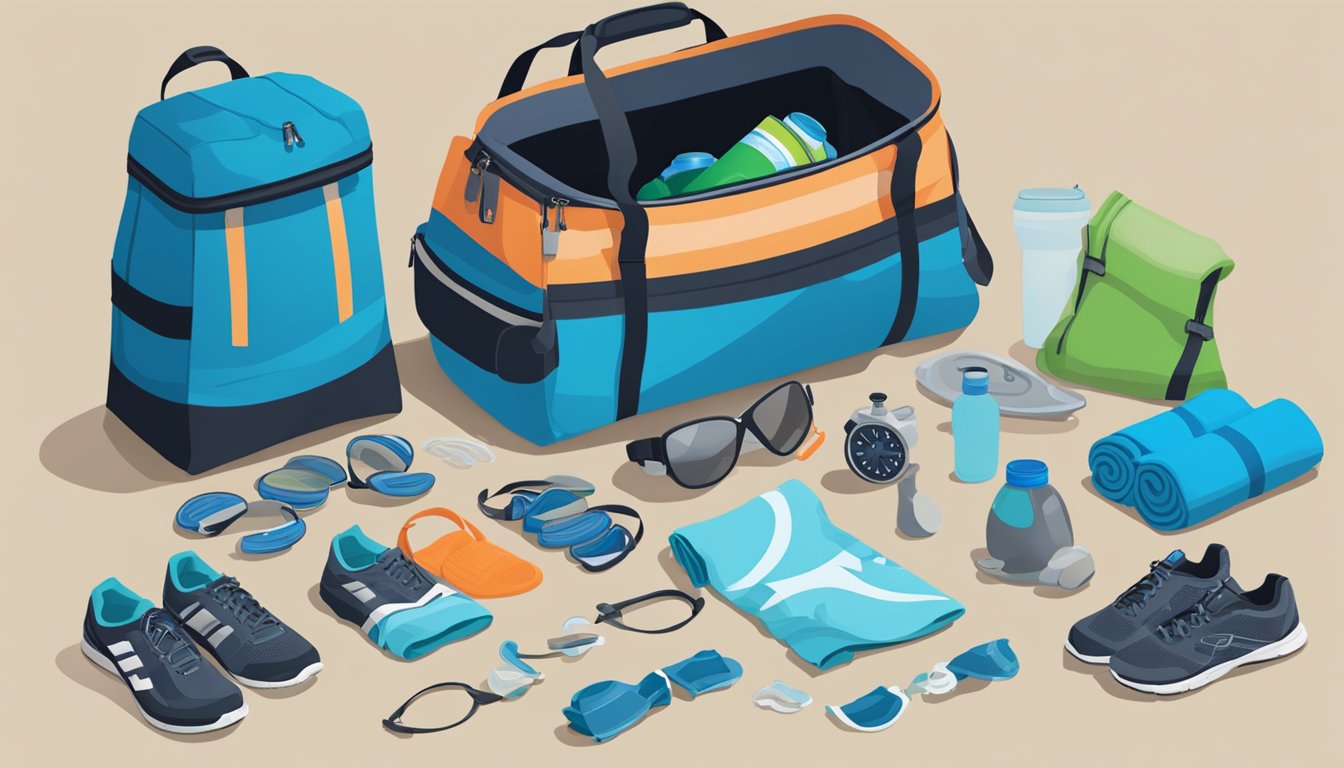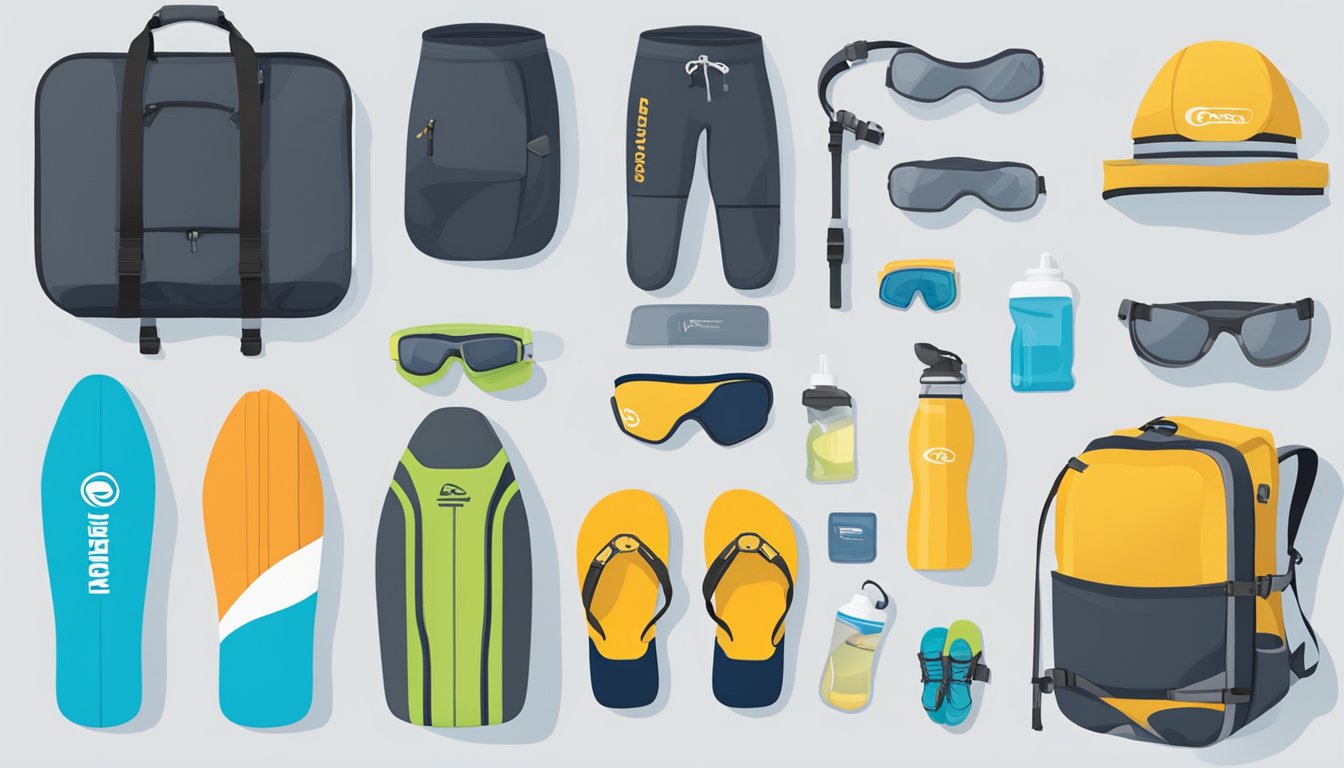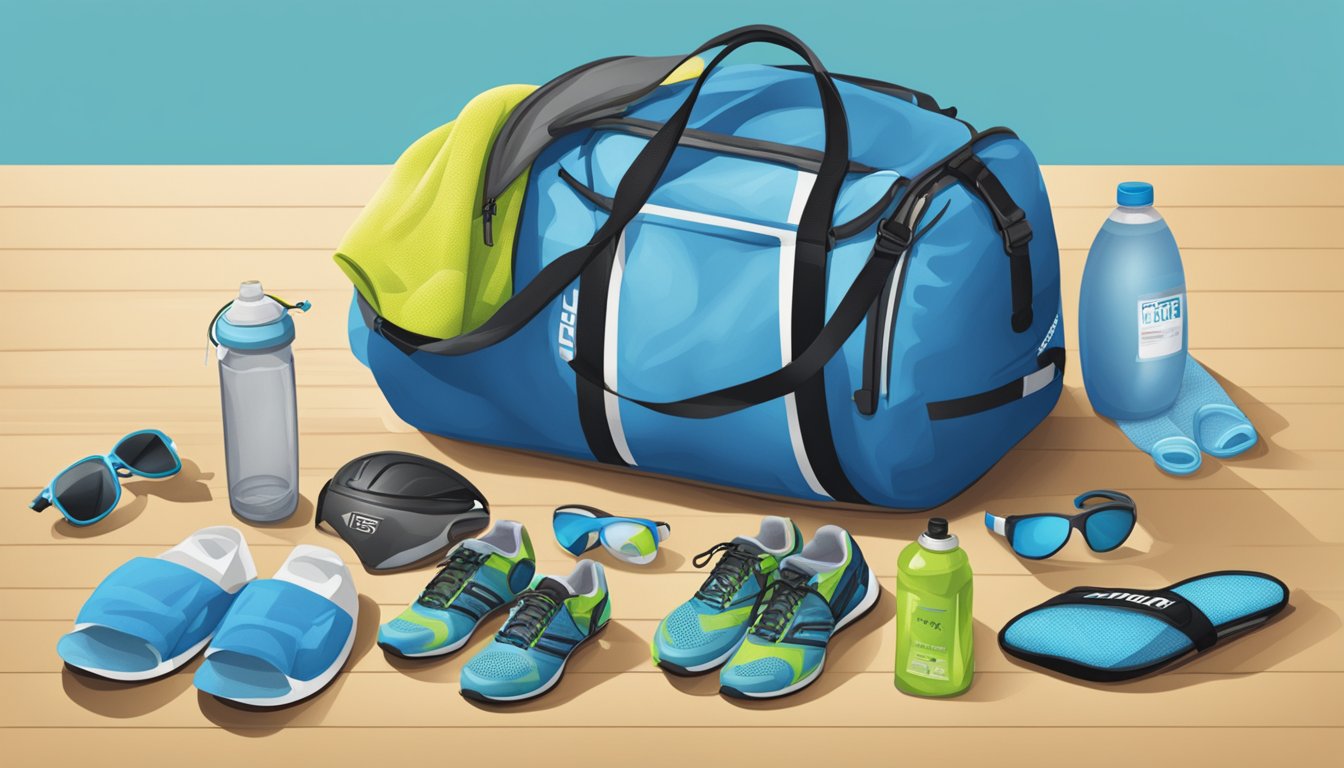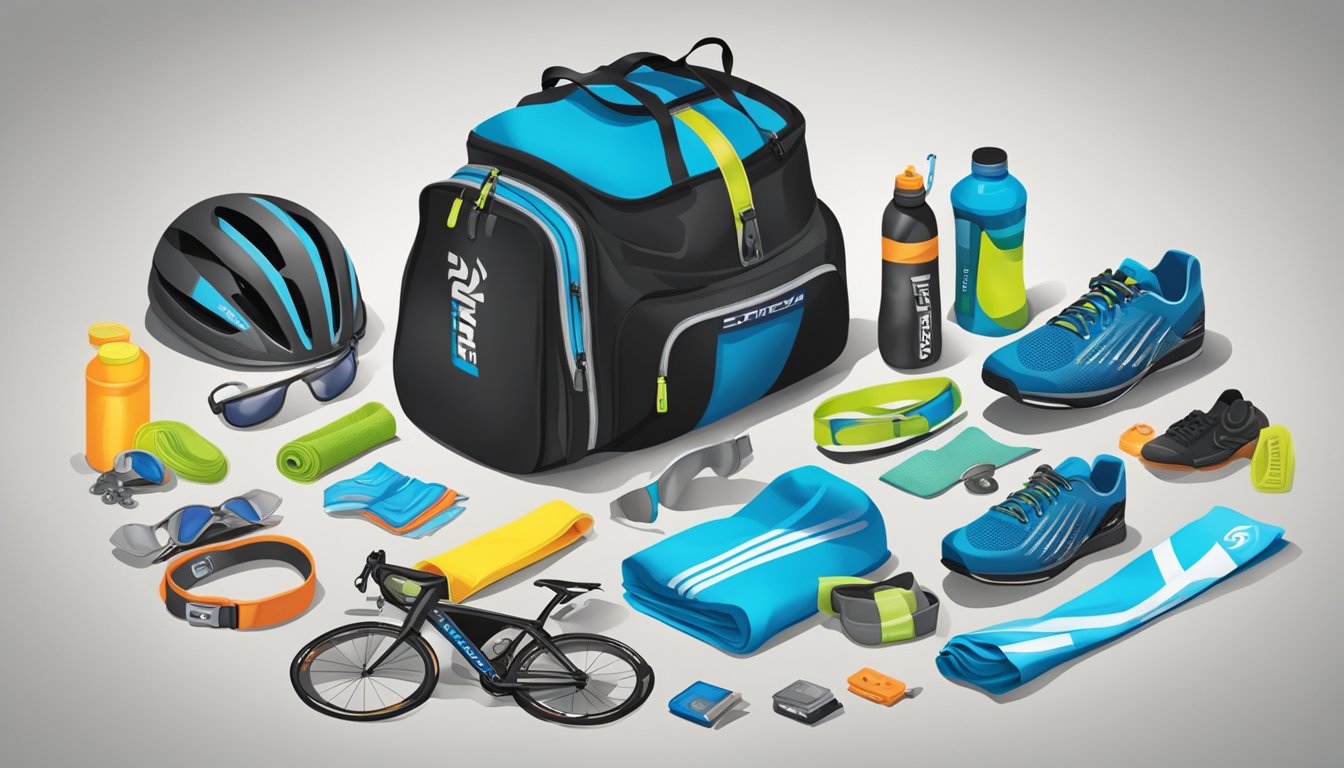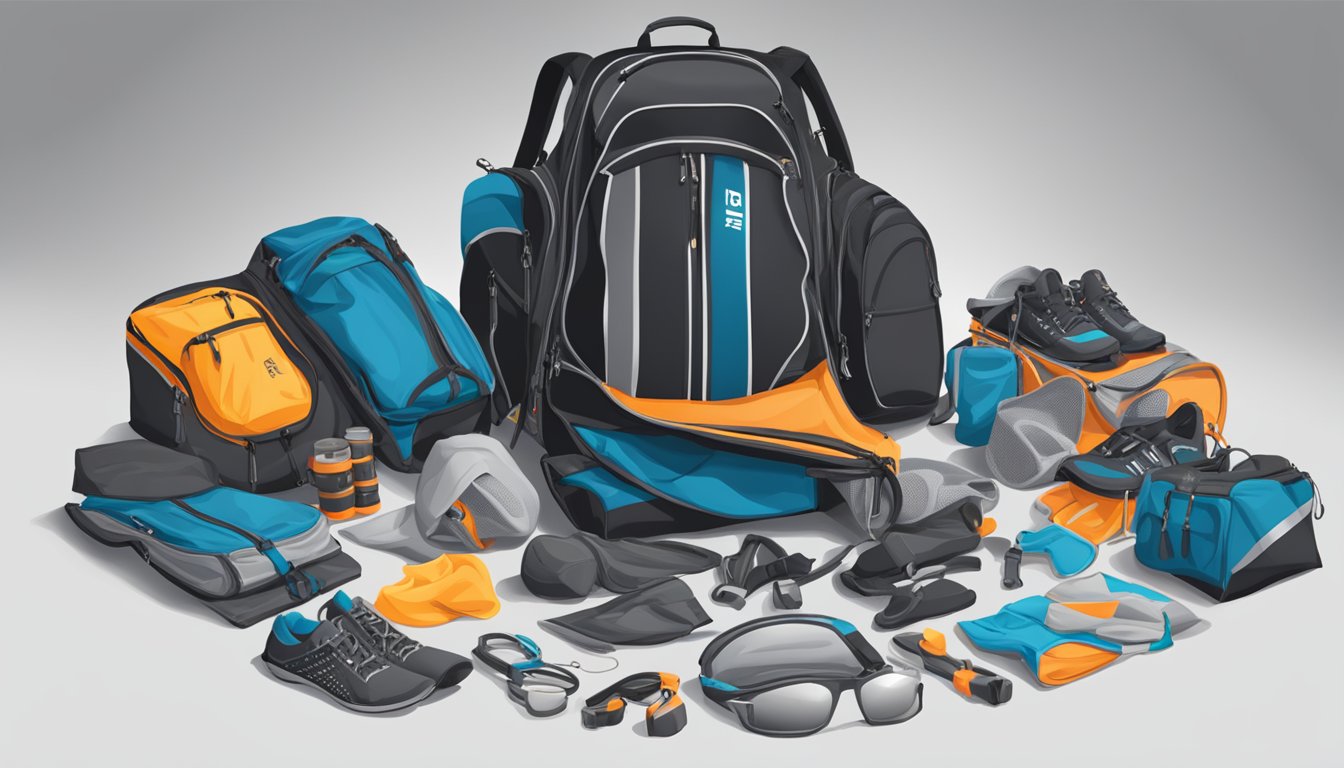If you’re new to triathlons, you might be wondering what a transition bag is and why it’s essential to have one. A transition bag is a bag that contains all the gear you need for each stage of the triathlon. It’s important to have a well-organized and properly packed transition bag to make the transition between each stage of the race as smooth as possible.
Packing a triathlon transition bag can be a bit overwhelming, especially if you’re new to the sport. However, with a bit of preparation and organization, you can pack your transition bag like a pro. In this article, we’ll go over everything you need to know about packing a triathlon transition bag, from what gear to include to how to organize it all. So, let’s get started!
Key Takeaways
- A transition bag is a bag that contains all the gear you need for each stage of the triathlon.
- Packing a triathlon transition bag can be overwhelming, but with preparation and organization, you can pack like a pro.
- In this article, we’ll go over everything you need to know about packing a triathlon transition bag, from what gear to include to how to organize it all.
Understanding Triathlon Transitions
https://www.youtube.com/watch?v=KkUjNZnTaUQ&embed=true
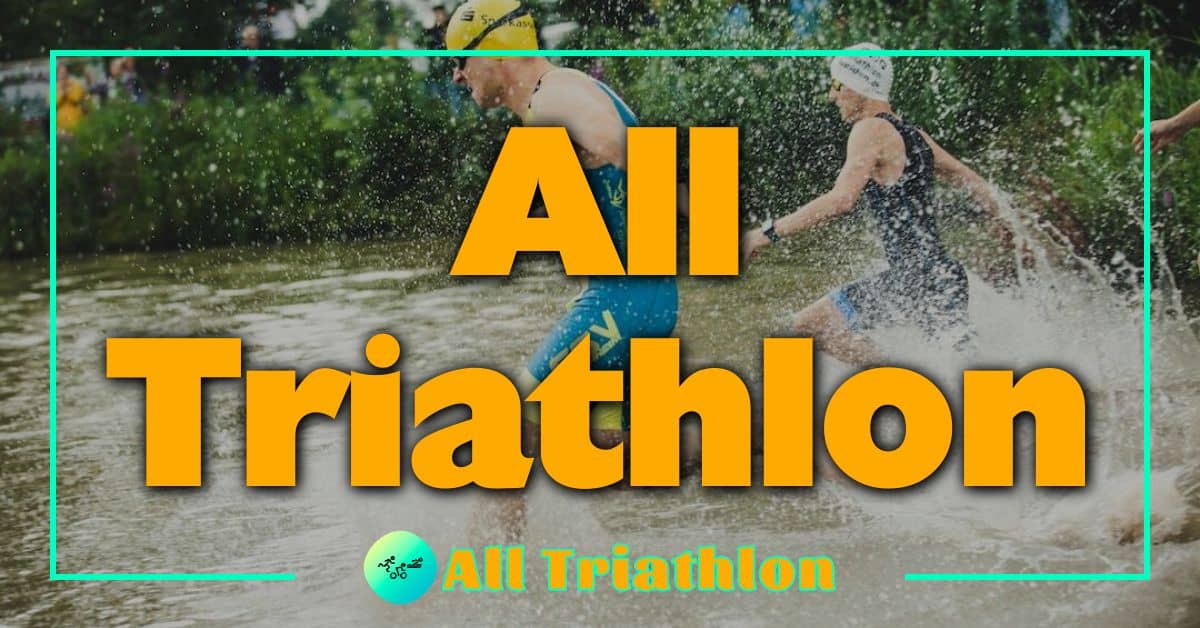
Triathlon transitions are the periods between each segment of the race where you change your gear and prepare for the next stage. There are two types of triathlon transitions: swim to bike (T1) and bike to run (T2). During T1, you change from your swim gear to your cycling gear, and during T2, you change from your cycling gear to your running gear.
It’s important to note that some triathlons are point-to-point races, meaning they start in one location and finish in another. In these events, you may have two different transition areas. For example, you may start your swim in one location and finish your bike in another. In this case, you will need to pack two separate transition bags: one for T1 and one for T2.
When packing your triathlon transition bag, it’s crucial to be organized and efficient. You don’t want to waste time fumbling through your bag during the race, so make sure you know exactly where everything is. Here are some tips to help you pack your transition bag like a pro:
- Use a checklist: Before you start packing, create a checklist of everything you need for each stage of the race. This will help you stay organized and ensure you don’t forget anything important.
- Pack in order: When packing your bag, pack your gear in the order that you will need it during the race. This will make it easier to find what you need quickly.
- Keep it simple: Don’t overpack your bag with unnecessary items. Stick to the essentials and only pack what you need for each stage of the race.
- Use separate bags: If you have a point-to-point triathlon, use separate bags for T1 and T2. This will make it easier to find what you need and avoid confusion during the race.
By following these tips, you can pack your triathlon transition bag like a pro and be ready for anything that comes your way during the race.
Essential Gear for Triathlon
https://www.youtube.com/watch?v=vutc099Cq_w&embed=true
When it comes to triathlon, having the right gear can make all the difference. Here are some of the essential items you should consider packing in your triathlon transition bag:
Swim Gear
You’ll need a swimsuit or wetsuit, swim cap, and goggles for the swim portion of the race. Make sure your goggles fit well and won’t fog up during the swim. A wetsuit can help keep you warm and buoyant in colder water.
Bike Gear
For the bike portion of the race, you’ll need a helmet, bike shoes, and sunglasses. Your helmet should fit snugly and be fastened securely. Bike shoes can help you transfer power more efficiently to the pedals, and sunglasses can protect your eyes from the sun and wind.
Run Gear
For the run portion of the race, you’ll need running shoes and a hat or visor. Your running shoes should be comfortable and broken in. A hat or visor can help keep the sun out of your eyes and protect your face from the sun.
Transition Bag
A good transition bag can help you stay organized and make transitions smoother. Look for a bag with compartments for each type of gear, such as a separate compartment for your bike shoes and running shoes. A race belt can also be helpful for holding your bib number.
Other Gear
Don’t forget to pack socks, especially if you’re wearing cycling shoes. You may also want to pack a small towel to dry off after the swim and to wipe your feet before putting on your shoes. And if you’re racing in cooler temperatures, consider packing a wetsuit or swimskin to keep you warm in the water.
By packing the right gear in your transition bag, you can set yourself up for a successful triathlon race.
Packing Your Transition Bag
https://www.youtube.com/watch?v=lHooGf9hvEE&embed=true
Packing your triathlon transition bag can seem overwhelming, but with a little organization and planning, it can be a breeze. A good transition bag should be easy to carry and have enough compartments to keep your gear organized.
When selecting a transition bag, look for one with ventilation to prevent your gear from getting musty. Many transition bags also double as backpacks or duffel bags, making them versatile for training sessions, race day, or travel.
Before packing your triathlon transition bag, make a checklist of all the gear you will need for each stage of the race. This will ensure that you don’t forget anything important.
When packing your bag, start with the items you will need first. For example, your wetsuit, goggles, and swim cap should be packed at the top of the bag for easy access during the swim portion of the race.
Next, pack your cycling gear, including your bike shoes, helmet, and sunglasses. Keep them together in a separate compartment or bag to make it easier to transition from the swim to the bike.
« Best Triathlon Helmets: Top Picks for Safety and Performance
Are Triathlon Bikes Comfortable? A Friendly Guide to Finding Your Perfect Ride »
Finally, pack your running gear, including your running shoes, race belt, and hat. Keep them together in another compartment or bag to make it easier to transition from the bike to the run.
Remember to pack any nutrition or hydration you will need during the race, such as energy gels, water bottles, or electrolyte tablets.
By following these tips, you can pack your triathlon transition bag like a pro and have a stress-free race day.
Nutrition and Hydration
https://www.youtube.com/watch?v=W0BC7ppu7MM&embed=true
When it comes to triathlon racing, proper nutrition and hydration are key to keep you going. Your body needs fuel to power through the swim, bike, and run portions of the race. Here are some tips on how to pack your triathlon transition bag with nutrition and hydration essentials.
Energy Gels, Bars, or Chews
Energy gels, bars, or chews are a great way to get a quick boost of energy during the race. They are easy to pack and consume on-the-go. Make sure to pack enough to last you through the race. Consider packing a variety of flavors to avoid taste fatigue.
Water Bottle or Hydration Pack
Staying hydrated is crucial during a triathlon race. Make sure to pack a water bottle or hydration pack to keep you hydrated throughout the race. Consider packing an extra water bottle in case one gets lost or damaged during the race.
Small Snacks
Small snacks like bananas, trail mix, or energy bars are great for a quick energy boost during the race. Pack snacks that are easy to eat and digest. Avoid packing snacks that are high in sugar or fat as they can cause stomach discomfort during the race.
Fuel and Electrolytes
Fuel and electrolytes are essential to keep you going during the race. Pack fuel like energy gels or bars to keep you energized, and electrolyte tablets to help replenish lost electrolytes. Make sure to pack enough fuel and electrolytes to last you through the race.
By packing the right nutrition and hydration essentials in your triathlon transition bag, you will be able to power through the race and cross the finish line strong.
Preparing for the Swim Transition
The swim transition is the first transition in a triathlon, and it is important to be well-prepared to make the transition as smooth as possible. Here are some tips to help you prepare for the swim transition:
Pack Your Transition Bag
Before the race, pack your transition bag with all the gear you’ll need for the swim, bike, and run portions of the race. For the swim portion, you’ll need goggles, a swim cap, and a towel to dry off after the swim. You may also want to consider packing a swimskin or wetsuit, depending on the water temperature and your personal preference.
Arrive Early
Arrive at the race site early to give yourself plenty of time to set up your transition area. Find a spot in the transition area and lay out your gear in the order you’ll need it for the race. This will help you save time and avoid confusion during the transition.
Wear Your Swim Gear
Wear your swim gear to the race site, including your swimsuit or wetsuit, so you don’t have to waste time changing before the swim. This will also help you get acclimated to the water temperature before the race.
Practice Your Swim to Bike Transition
Practice your swim to bike transition before the race so you can do it quickly and efficiently on race day. You may want to practice taking off your wetsuit or swimskin, putting on your cycling shoes, and grabbing your bike.
By following these tips, you can be well-prepared for the swim transition and set yourself up for a successful race.
Getting Ready for the Bike Transition
https://www.youtube.com/watch?v=ACCTzuRWUTM&embed=true
The bike transition is where you switch from the swim to the bike portion of the triathlon. It’s important to have everything you need in your transition bag so you can quickly and efficiently get on your bike and start pedaling.
First, make sure your bike is in the right gear before you start the race. You want to be in a gear that allows you to easily start pedaling without too much resistance. This will save you time and energy when you’re trying to get up to speed.
Next, lay out your bike gear in a systematic way. You want to be able to quickly find everything you need without wasting time searching through your bag. Here’s a suggested layout:
- Bike shoes: Place your bike shoes upside down on your towel or mat. This will make it easier to slip your feet in and out of them quickly.
- Cycling gear: Put on your cycling shorts and jersey before you put on your helmet. This will help you avoid getting tangled up in your helmet straps.
- Helmet: Put on your helmet and fasten the chin strap securely. Make sure the helmet is snug and level on your head.
- Sunglasses: Put on your sunglasses to protect your eyes from the sun and wind.
- Race belt: Clip your race belt around your waist. This is where you’ll attach your race number so it’s visible during the bike and run portions of the race.
Finally, make sure your bike is ready to go. Check your tires to make sure they’re properly inflated and in good condition. Make sure your brakes are working properly and your chain is lubricated.
Once you’re all set, head to the bike rack and find your bike. Remember your bike’s location so you can quickly find it when you come back from the bike portion of the race. With these tips, you’ll be ready to smoothly transition from the swim to the bike and start pedaling towards the finish line.
Setting Up for the Run Transition
Congratulations! You’ve made it through the swim and bike legs of the triathlon, and now it’s time to transition to the run. Here are some tips to help you set up your transition bag for the run leg of the race.
Running Shoes
Make sure you have your running shoes in an easily accessible spot in your transition bag. You don’t want to waste time searching for them when you need to get going. Consider placing them at the top of your bag or in a separate compartment.
Running Gear
Pack your running gear, such as shorts and a shirt, in a way that makes them easy to grab and put on quickly. Fold them neatly and place them in a specific spot in your bag. Consider using a packing cube or compression sack to keep them organized.
Running Socks
Don’t forget to pack a fresh pair of running socks. Moisture-wicking socks are a great choice to help keep your feet dry and prevent blisters. Consider packing an extra pair just in case.
Hat or Visor
If you plan to wear a hat or visor during the run, make sure it’s in an easily accessible spot in your bag. You may want to consider packing it on top of your running gear or in a separate compartment.
Final Check
Before leaving the transition area, do a final check of your bag to make sure you have everything you need. Double-check that you have your running shoes, running gear, socks, and hat or visor. Make any necessary adjustments to your bag to ensure everything is easily accessible.
By following these tips, you’ll be able to quickly transition from the bike to the run leg of the triathlon. Good luck, and have fun!
Additional Items to Consider
Aside from the essential items, there are other things you may want to consider packing in your triathlon transition bag. These items can help make your race more comfortable and enjoyable.
Sunscreen
Don’t forget to pack sunscreen in your transition bag. You’ll be out in the sun for a long time, and you don’t want to get sunburned. Apply sunscreen before the race and reapply during the race if necessary.
Checklist
Create a checklist of all the items you need to pack in your transition bag. Check off each item as you pack it to ensure you don’t forget anything. Having a checklist can also help you stay organized and reduce stress on race day.
Designated Area
When you arrive at the race, find a designated area where you can set up your transition bag. This area is typically marked with your race number or a specific color. Make sure you set up your bag in the correct area to avoid confusion.
Changing Tent
Some races provide a changing tent where you can change into your cycling or running gear. If your race provides a changing tent, make sure you pack a towel and any extra clothing you may need.
Pockets
Look for a transition bag with pockets. Pockets can help you stay organized and make it easier to find your items during the race.
Miscellaneous
Consider packing some miscellaneous items in your transition bag, such as a hat or sunglasses. These items can help protect you from the sun and make your race more comfortable.
Personal Items
Pack any personal items you may need, such as medication or contact lenses. Make sure you have enough of these items to last throughout the race.
First Aid Kit
Pack a small first aid kit in your transition bag. Include items such as band-aids, antiseptic wipes, and pain relievers.
Dry Clothes
Pack a change of clothes for after the race. You’ll want to change out of your sweaty race clothes as soon as possible.
Timing Chip
Make sure you pack your timing chip in your transition bag. You don’t want to forget it and miss out on your official race time.
Chamois Cream
If you’re cycling, consider packing chamois cream in your transition bag. Chamois cream can help reduce friction and prevent chafing.
GPS Watch
If you have a GPS watch, make sure you pack it in your transition bag. Your GPS watch can help you track your progress during the race.
Co2
Pack a Co2 cartridge in your transition bag in case you get a flat tire during the race.
Reward
Finally, don’t forget to pack a reward for yourself in your transition bag. Whether it’s a favorite snack or a cold drink, having a reward waiting for you at the end of the race can help motivate you to finish strong.
Choosing the Right Transition Bag
When it comes to triathlon, preparation is key to a successful race. One of the most important pieces of equipment you’ll need is a triathlon transition bag. The right bag will keep your gear organized, safe, and protected during transportation. Here are a few things to consider when choosing the right triathlon transition bag for you:
Durability
You want a bag that is durable and can withstand the rigors of travel and the race. Look for a bag made of high-quality materials that can handle wear and tear. A durable bag will also last you for many races to come.
Convenience
You want a bag that is convenient to use. Look for a bag that is easy to pack and unpack, with compartments that keep your gear organized. You also want a bag that is easy to carry, with comfortable straps that won’t dig into your shoulders.
Size
You want a bag that is the right size for your gear. Look for a bag that is big enough to hold all your gear, but not so big that it becomes cumbersome to carry. You also want a bag that is small enough to fit in the overhead compartment of a plane or in the trunk of your car.
Price
You want a bag that is affordable. Look for a bag that fits your budget, but don’t sacrifice quality for price. A good triathlon transition bag is an investment in your sport, so it’s worth spending a little extra to get a bag that will last.
Change of Clothes
You want a bag that has enough space for a change of clothes. After the swim, you’ll need to change into your cycling gear, and after the bike, you’ll need to change into your running gear. Look for a bag that has a separate compartment for your change of clothes, so you can easily find what you need.
In conclusion, choosing the right triathlon transition bag is an important part of your race preparation. Consider the bag’s durability, convenience, size, price, and space for a change of clothes when making your choice. With the right bag, you’ll be able to focus on the race, knowing that your gear is safe and organized.
Final Tips and Advice
Congratulations! You’ve packed your triathlon transition bag and you’re ready to go. Before you head to the race, here are a few final tips and advice to keep in mind:
Stay Organized
Keeping your transition bag organized is key to a smooth race day. Make sure all your gear is in its proper place and easy to find. Use small bags or pouches to keep items separated. For example, put your nutrition in one bag, your race belt and number in another, and your wet suit in a separate bag. You can use a checklist to make sure you have everything you need and that it’s all packed.
Practice, Practice, Practice
Don’t wait until race day to figure out how to use your transition bag. Practice packing and unpacking your bag before your training sessions and races. This will help you become more familiar with your gear and ensure you don’t forget anything important. It will also help you identify any potential issues, such as items that are difficult to find or pack.
Be Prepared for Ironman Races
If you’re planning to participate in an Ironman race, keep in mind that the rules may be different. Ironman bags are typically provided for athletes to use on race day, and you may be required to drop off your bags at specific times. Make sure you read the race rules and instructions carefully so you know what to expect.
Take Care of Your Triathlon Kit
Your triathlon kit is an important part of your race day gear. Make sure you take care of it properly so it lasts a long time. Wash your kit after each use, and store it in a cool, dry place. Check for any signs of wear and tear, and replace any items that are worn out or damaged.
Don’t Forget Your Race Number
Your race number is an important part of your race day gear. Make sure you attach it to your race belt or triathlon kit before you leave for the race. You don’t want to be scrambling to find it at the last minute.
Take Care of Your Wet Suit
If you’re using a wet suit for your race, make sure you take care of it properly. Rinse it with fresh water after each use, and hang it up to dry. Don’t leave it in direct sunlight or in a hot car. Check for any signs of wear and tear, and replace it if necessary.
Remember, packing your triathlon transition bag is just one part of your race day preparation. Keep training hard, stay focused, and have fun!
Frequently Asked Questions
What are some essential items to pack in a triathlon transition bag?
When packing a triathlon transition bag, it’s important to include all the essentials you will need for each stage of the race. Some of the essential items you should pack include:
- Race bib and safety pins
- Triathlon suit or swimwear, goggles, and swim cap
- Cycling shoes, helmet, sunglasses, and gloves
- Running shoes, hat or visor, and race belt
- Towel to dry off and wipe feet
- Water bottles and hydration system
- Nutrition such as energy gels, bars, and electrolyte drinks
- Sunscreen and chamois cream
How can I organize my triathlon transition bag for maximum efficiency?
Organizing your triathlon transition bag can help you save time during the race. Here are some tips for maximum efficiency:
- Use separate bags or compartments for each stage of the race
- Pack items in the order you will need them during the race
- Attach your race bib to your triathlon suit or race belt ahead of time
- Place your cycling shoes and helmet on top of your bag for easy access
- Use a brightly colored towel to help you locate your transition area quickly
What are some tips for packing a triathlon transition bag for a race?
When packing your triathlon transition bag for a race, here are some tips to keep in mind:
- Pack your bag the night before the race to avoid last-minute stress
- Make a checklist of all the items you need to pack and double-check it before leaving for the race
- Pack a few extra items such as safety pins, spare tubes, and tire levers in case of emergencies
- Use a waterproof bag or plastic bags to protect your items from rain or water during the race
How do I decide what to pack in my triathlon transition bag?
Deciding what to pack in your triathlon transition bag can depend on several factors such as the race distance, weather conditions, and personal preferences. Here are some things to consider when deciding what to pack:
- The distance of the race and the expected duration
- The weather conditions and temperature forecast
- Your personal needs and preferences such as nutrition and hydration requirements
- The rules and regulations of the race
What should I pack in my morning clothes bag for an Ironman race?
For an Ironman race, you will need to pack a separate bag for your morning clothes that you will wear before the race. Here are some items to pack in your morning clothes bag:
- Warm clothing such as a jacket or sweater to wear before the race
- Flip flops or sandals to wear before and after the race
- A change of clothes for after the race
- A trash bag to sit on or use as a poncho if it rains
What are some common mistakes to avoid when packing a triathlon transition bag?
When packing your triathlon transition bag, it’s important to avoid common mistakes that can affect your race performance. Here are some mistakes to avoid:
- Forgetting essential items such as race bib, nutrition, or hydration
- Overpacking your bag with unnecessary items that can slow you down
- Not organizing your bag for maximum efficiency
- Packing items in the wrong order or forgetting to attach your race bib ahead of time

